Bristol Business News travel editor Anne Gorringe heads away from Tenerife’s popular coastal resorts to discover vineyards, banana plantations and Spain’s highest peak on a fascinating trip to the island…
Snuggled in my ski jacket, scarf wound tightly around my neck, I brace myself against the chill wind coming down the mountain.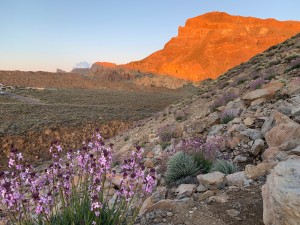
It’s my first time on Tenerife, the largest of the Canary Islands and known for its year-round sunshine.
Beautiful flowers grow out of the Mars-like cracks and crevices at the top of Mount Teide
So why am I dressed as if I’m going for a midwinter stroll in England? The answer is I’m 2,400m up Tenerife’s 3,718m-high volcano Mount Teide at sunset to witness the last orange rays of the day slide over the rocks.
As the sun goes down both the views – and the wind whistling in – take my breath away.
My viewing point is in the Teide UNESCO national park, where the terrain of jagged rocks is said to be so similar to Mars that NASA ‘trained’ its 2020 Perseverance rover here.
It’s also the end of the road that snakes up the volcano. It’s a perfect stopping point for coaches bringing tourists up the mountain in the middle of the island as well as travellers booked in for an overnight stay at the small Parador Hotel, where they can rise at dawn to watch the sun climb over the mountain.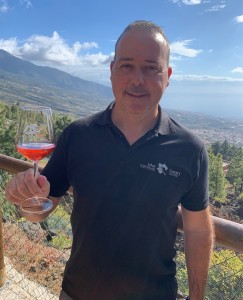
It’s not what I expect on a trip to Tenerife. I’d spent the previous days enjoying 20-plus degree temperatures and sampling delicious wines at a couple of vineyards.
Ruben Ferrera at his Bodegas Ferrera vineyard on the slopes of Mount Teide
One, the family-run Bodegas Ferrera in Arafo, offers ‘high-altitude’ and organic wines and sits on the steep the side of the mountain between the volcano above and the pine forest below.
On the drive up, I pass hardy cyclists battling the steep hillside roads. Tenerife has become a firm favourite for cyclists – but it’s certainly not for beginners. British road racing cyclist Chris Froome is among the big names who’ve chosen to train here.
At the vineyard, manager Ruben Ferrera, whose grandfather Tomas created it from scratch, explains that quality is the key to the success of the business.
It’s hard work and a labour of love for Ruben, who trained and worked as a lawyer for 15 years before deciding to join the family business.
On a second vineyard tour I discover Bodega Monje, closer to the coast and the historic city of San Cristóbel de La Laguna – once the island’s capital.
Again, the wines are delicious. No wonder, some of the well-established vines here are more than 100 years old and I particularly loved its unique white wine.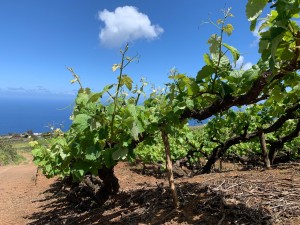
Locals, however, generally prefer to drink red. It’s certainly the most popular tipple in Tenerife, accounting for 80 % of all bottles sold.
Bodega Monje vineyard’s 100-plus year old vines
Like many companies during the pandemic, Bodega Monje had to use its initiative to survive. It began offering unique events – fun, theatre-style nights held in the cellars – as well as creating its own craft beer range.
It’s not just vines that grow on Tenerife. Fruit is also big news here and its bananas, being organic, have their own special flavour.
At Finca La Calabacera beneath the foothills of El Teide, organic bananas are grown alongside more exotic fruits, including papaya and black sapote, the so-called ‘chocolate pudding fruit’.
On our approach, I notice walls are built around the planation and there are also ‘nets’ over the top of the plants – creating a curtain to keep out that wind.
Our guide explains: “Bananas are a tropical fruit – but we are not a tropical island, so we need this protection from the wind.”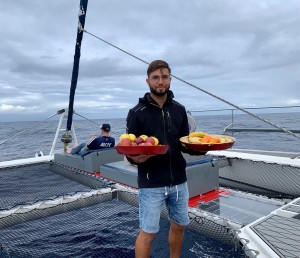
In the 19th century the sea trade in fruit between the Canary Islands and the UK was massive – hence the origins of the name of what is now London’s financial centre, Canary Wharf.
Whale-watching trip, with breakfast, on White Tenerife’s catamaran
Obvious, once you know! (These days, of course, the vast majority of the UK’s bananas come from Latin America.)
Tenerife is an island of two halves and my visit was a two-centre trip starting in La Caleta in the south.
Some of Tenerife’s southern resorts have, of course, had a reputation for ‘fly-and-flop’ holidays. But I’m here for adventure and La Caleta is a perfect spot to sign up for one of the daily whale-watching catamaran trips from nearby Puerto Colón with eco-company White Tenerife.
White Tenerife practically guarantee that you get to see pilot whales and dolphins all year round. And, true to form, I did – though I admit to being envious of the lucky travellers who, next day, also spotted a turtle. At €30 (£25.80) for a three-hour tour, including breakfast, this trip is a bargain.
The north of the island, in contrast to the southern half, is less developed and the landscape visibly more lush – Canarian pine and dragon trees abound here.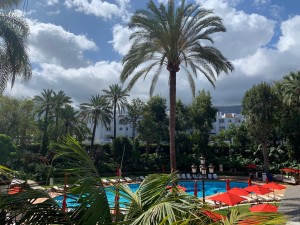 I stayed at the Hotel Botanico in charming Puerto De La Cruz.
I stayed at the Hotel Botanico in charming Puerto De La Cruz.
The beautiful gardens at Hotel Botanico in Puerto De La Cruz
Tourism here is well-established and this pretty town, with its stylish boardwalks and beaches, has been welcoming visitors since the late 19th century.
It’s also a great base for discovering pretty San Cristobal de La Laguna. With its colourful houses, cobbled streets and elegant old mansions, it’s now a UNESCO world heritage site.
La Laguna’s streets are laid out in a grid system, developed by the architect Leonardo Torriani in 1585.
It was then used as the blueprint for towns in Latin America and, walking around La Laguna, passing colourful buildings and historic houses is reminiscent of Havana.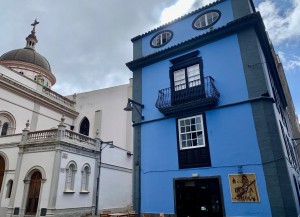
One of La Laguna’s characteristics is the profusion of beautiful wooden balconies gracing some of the older buildings.
One of the colourful buildings on the main street in La Laguna
If you miss them, step inside the main tourist office and peek at the inner tiled courtyard overlooked by pretty balconies.
And, when you are shopping on the mains street, don’t miss the tiny alleyways between the shops.
I slipped down one and discovered TinTin’s, a groovy bar with a pretty courtyard and literally just metres from the main drag.
When it comes to partying, Tenerife can boast the biggest carnival outside Rio de Janeiro. The annual carnival in Santa Cruz de Tenerife is billed as “the biggest street party in Europe”.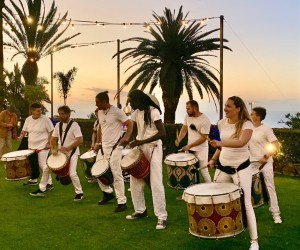
Usually held each February, this year’s carnival was delayed until June due to post-Covid changes. But it’ll be back to its usual spot next year.
Drummers rehearsing for Tenerife’s annual carnival
I managed to get a glimpse of a few of the energetic musicians dancing as they performed, working up a sweat as they practiced for their big day.
I needed to cool off too and the best place on the island to do that is the waterpark Siam Park. It’s within reach of most of Tenerife’s towns and well worth a day trip.
But this is no ordinary waterpark. Voted the ‘best in the world’ for five years running on TripAdvisor, it has wave machines and a relaxingly lazy river which snakes its way through the park for 1km.
But what really makes it special is the spectacular design of its buildings – all created along traditional Thai specifications and making you feel as if you’ve suddenly been transported to Bangkok.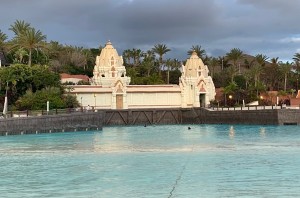
Siam Water Park’s buildings are modelled on Thai designs
Of course, wherever you go in Tenerife, Mount Teide can usually still be spotted in the distance.
And if you really want to get right to the very top, there’s a cable car than can take you or hikers can trek to the peak – but only with a special permit. Plan, and book in advance if you’re keen.
Personally, I think a sunset trip into the national park is a must. It may not look like Thailand, but the orange glow on the rocks does remind me of Australia’s Ayres Rock.
And when the sun sets, this is one of the best places in the world to stargaze with professional guides, who even set up telescopes for you. Magical!
FACT FILE:
GETTING THERE: EasyJet operates direct flights from Bristol to Tenerife’s airport in the south of the island on four days of the week in July and August, five days of the week in September and seven days a week from November onwards. www.easyjet.com 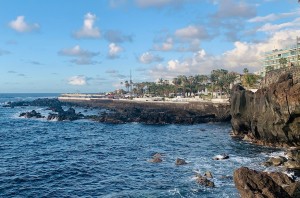
STAY IN: Five-star luxury in the north of the island at the recently renovated Hotel Botanico in Puerto de la Cruz. The hotel is next to the city’s Botanical Gardens hotelbotanico.com. In the south of the island, 4.5-star Hotel Sheraton La Caleta, next to the beach, pictured, has a great selection of swimming pools and is a handy spot for whale-watching trips. (The hotel is currently closed for refurbishment).
TRY WHALE-WATCHING: The White Tenerife company offers a three-hour catamaran eco-excursion whale and dolphin experience, plus a chance to try snorkelling. Sustainability is key to this company and knowledgeable staff give you a wildlife talk en route. White Tenerife
TAKE TO THE WATER: Tickets to Siam Water Park start at €28. Siam Park Tenerife
SAMPLE THE WINE: It’s worth getting a taxi to Arafo to visit the Bodegas Ferrera winery for a three-hour tour. Here you get to taste four wines and four tapas for €30. Bodegas Ferrera
WALK ON A VOLCANO: The volcanic plateau of Mount Teide is a protected UNESCO World Heritage site. Book a trip on the cable car to zoom up to the 3,555m viewing area. Or arrange a trek (permit included) with a guided tour. www.volcanoteide.com
GO STARGAZING: Professional guides can help you discover the stars from the dark sky area on Mount Teide. Book at Volcano Teide
ENJOY CARNIVAL: The huge carnival parade in Santa Cruz, second only to Rio’s, is back to its usual February spot next year. Tenerife Carnival






























